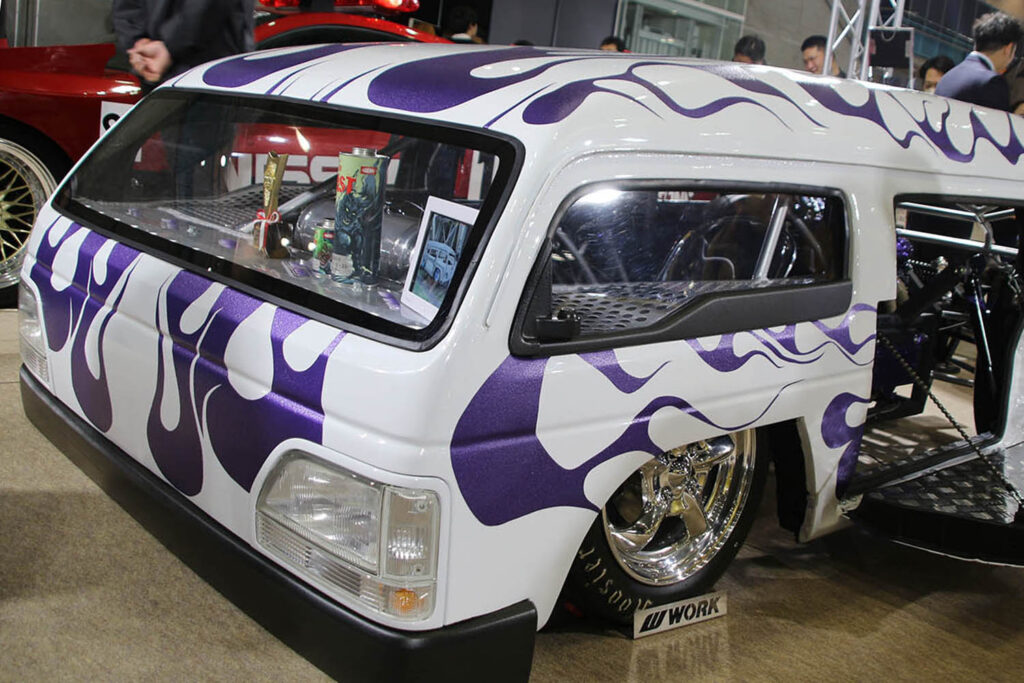Discover the work of creative students
Tokyo Auto Salon 2024 was held from January 12 to 14, 2024. The venue is Makuhari Messe, as it has always been, and while tuning/dress-up stores were the main exhibitors when the show first started as the Tokyo Exciting Car Show in 1983, car manufacturers have also been running large booths since the late 1990s. Nowadays, visitors can enjoy high-quality concept cars, creative tuning cars, and dress-up cars.
Based on three cars, the project was completed
This year again, exhibitors from major automakers, well-known tuners, and driving schools presented exciting cars, but the “HOT ROTY” built by the Shizuoka Professional College of Automobile Technology on a budget of only 1 million yen was a dress-up compact car that astonished everyone who saw it. It was a dress-up compact car that astonished everyone who saw it.
I had no idea how it was built, so I read the concept of the car’s production on the display plate (explanation board) right next to the HOT ROTY, and this is what it said.
“This is an American customized ghetto hybrid based on Honda Acty, Honda Street, and Formula Hayabusa. If you ride this, you, too, will surely be the fastest on the footpaths!
Unfortunately, I could not visualize the process of completion by reading this text, so I interviewed a student who was near HOT ROTY. He answered in this way.
“What should we choose for the custom car to be displayed at the Auto Salon? We came up with various ideas when we were discussing it together, but the concept of HOT ROTY seemed the most interesting! So we started building it at the end of the summer vacation and completed it at the end of December. The clear file here describes the production process, so please take a look if you like.”
The path to the completion of the wide and low body
Oh, I appreciate that, so I took a look at the clear file and found that the production process was described step by step, starting from the point where the student rescues the Honda Street left in the grass. The short version is this.
First, the rescued Honda Street was brought to the school and stripped completely. Then, the floor was cut off using a reciprocating saw and grinder. We also disassembled the engine of the Formula Hayabusa, which had been used at Shizuoka Professional College of Automobile Technology, while confirming that the engine would run. Using the original frame as a base, the suspension and frame structure were modified to fit the new body to be built.
Next, the body of the Honda Street was cut horizontally to shorten the overall height, a custom process called sectioning. The width was reduced by 32 cm, and at the same time, the front wheelhouses were extended forward by about 13 cm.
The next step was a customization called “chop-top” to lower the roof, and at the same time, the body was widened. The chopped top was 25 cm and the widened width was also 25 cm, creating a wonderfully wide and low body. However, this was the most difficult part of the process, as the angle was adjusted while moving all the pillars and widening the roof during the chopping process. The student’s favorite car, the Acty, was used as a parts supplier for this modification.
The body was reinforced with steel pipes and modified so that the ride height could be adjusted by using bags for air suspension for the body mounts. Once the body was surfaced and temporarily assembled, it was displayed at a car event in November, where it received an award. The detailed parts were worked on after this event.
To custom paint the body, a base coat of white was first applied. Next, the fire pattern masking was almost freehanded by the student and painted in purple, and after removing the masking, clear was placed on top. Then, the white area was now masked and the clear beast was applied on top of the purple. While applying the chipping paint, another coat of purple was applied over it. Finally, the body and chassis were combined, and the Formula Hayabusa engine was mounted to complete the project.
We may be able to see more scenes of the car running on the SNS of the Shizuoka Professional College of Automobile Technology in the future, so we will keep a close eye on its progress.
